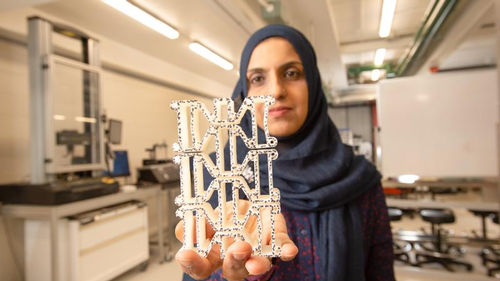FRIDAY, NOVEMBER 5, 2021
A professor from the Queensland University of Technology was recently inspired by a material commonly found in running shoes and memory foam pillows to better protect buildings from collision and high-impact damages.
Working in QUT’s Center for Materials Science and School of Civil and Environmental Engineering, Tatheer Zahra has turned to an off-the-shelf bioplastic in developing 3D-printed shapes to mimic the behavior of auxetic materials.
Her research has since been published in Smart Materials and Structures.
“Rather than flattening when stretched or bulging when compressed, auxetic materials expand or contract in all directions at once, which makes them highly energy-absorbent and load resistant,” Zahra said. “But existing commercial auxetic material is expensive and not locally available, so I designed geometric shapes that achieved the same behavior.”

 |
| Queensland University of Technology |
|
A professor from the Queensland University of Technology was recently inspired by a material commonly found in running shoes and memory foam pillows to better protect buildings from collision and high-impact damages. |
According to Zahra, the auxetic materials, when printed in a variety of geometric shapes, could potentially replace steel and fiber-reinforced polymer mesh reinforcements commonly found in composites and could also be used as a flexible protective wall render.
The university further explains in a video that 180 grams of auxetic geometry can resist 25 kilonewtons of force (approximately 2500 kilograms) by contracting in all directions to absorb energy of around 260 joules without showing damage or changes in shape when released. If scaled-up, these geometries could be useful in saving buildings and other structures from collision impact.
“At scale, composites embedded with these geometries could theoretically resist high impact or shock energy caused by gas explosions, earthquakes and wind forces, and car collisions,” said Zahra, adding that the energy absorption would be equivalent to a 20-millimeter-thick reinforced composite protective render over a full-scale building wall, which could potentially withstand the impact force of a car travelling at 60 kilometers per hour.
“In Australia, there’s an estimated 2,000 vehicular crashes each year. Direct building damage cost at 2.5% would put the damage bill at about $38.65 million/year for housing. Since vehicles also crash into apartments, office building, restaurants and convenience stores, this cost of building damage would probably be higher.
“Loss of life would be the highest cost.”
She went on to explain that protection for masonry walls was especially important, in that it is the essential part of most commercial and residential buildings.
“Masonry is a very cheap material that is resilient to noise, heat and has better fire protection properties compared to wood or steel, but its mortar joints weaken the overall structural strength,” Zahra said.
“If auxetic geometries were embedded into the mortar to make protective composites, they would also be protected from microorganisms and temperatures over 60 C, and should last the design life of the structure.”
In addition to its collision protection properties, Zahra reported that the auxetic material also provides a more sustainable, low carbon emission alternative to fiber-reinforced plastic or other non-biodegradable polymers.
The bioplastics are also more cost effective when compared to using auxetic fabrics, which could cost up to $400 per square meter and are not biodegradable.
In moving onto the next steps of her study, Zahra reports that she’s aiming to test the designs on full scale masonry and concrete structures at the university’s Banyo Pilot Plant.
“The designs would be good prospects for commercialization through additive manufacturing because the production process is flexible and materials are readily available,” Zahra concluded. “3D printing would also allow us to change the material, size or design of geometric shapes to suit different structures and load requirements.”
Tagged categories: 3D Printing; Building facades; Colleges and Universities; Design; Design - Commercial; Good Technical Practice; Health and safety; Research; Research and development; Safety